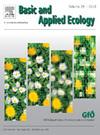Bird guilds need different features on city squares
IF 3.5
2区 环境科学与生态学
Q2 ECOLOGY
引用次数: 0
Abstract
Urban green spaces provide habitats for animals. However, animals differ in habitat requirements depending on their traits. Consequently, it remains unclear how animal guilds differ in their response to characteristics of urban green spaces like shrubs, trees or grass. Using birds inhabiting city squares in Munich as a model system, we ask: Do trait-based bird guilds respond differently to characteristics of small green spaces? What is the difference between an urban-adapted bird community and an exploiter like the Feral Pigeon (Columba livia f. domestica)? Do the responses of guilds and the Feral Pigeon differ between spring and winter?
We show that all guilds profited from green structures, and most guilds benefited from trees and grass cover on city squares. Additional green characteristics influenced some guilds. Cavity-breeding birds needed old trees, and ground-nesting birds decreased with the presence of domestic animals but increased with the shrub volume on a square. Also, insectivorous birds increased with an increasing number of old trees on a square. In contrast to these guilds, the Feral Pigeon did not react to any green characteristic but increased with the abundance of people. Only a few guilds showed differing responses for single variables between seasons. A community analysis revealed that squares differed in the abundance of guilds and the Feral Pigeon. We, therefore, confirm the positive effects of creating urban vegetation for many bird guilds but suggest to plan urban green spaces diversely considering the particular needs of different guilds to promote urban biodiversity.
鸟类公会需要城市广场的不同特征
城市绿地为动物提供了栖息地。然而,动物对栖息地的要求取决于它们的特征。因此,目前尚不清楚动物行会对城市绿地(如灌木、树木或草地)特征的反应有何不同。以栖息在慕尼黑城市广场的鸟类为模型系统,我们提出了这样的问题:基于特征的鸟类协会对小型绿地的特征有不同的反应吗?适应城市的鸟类群落和像野鸽(Columba livia f. domestica)这样的掠夺者有什么区别?行会和野鸽的反应在春季和冬季有什么不同吗?我们发现所有公会都从绿色建筑中获利,而大多数公会都从城市广场上的树木和草地中获利。额外的绿色特性影响了一些公会。洞巢鸟需要古树,地巢鸟随着家畜的存在而减少,而随着广场上灌木的增加而增加。此外,食虫鸟类随着广场上古树数量的增加而增加。与这些行会不同的是,野鸽对任何绿色特征都没有反应,而是随着人数的增加而增加。只有少数行会对不同季节的单一变量表现出不同的反应。一项社区分析显示,方块在公会和野鸽的数量上有所不同。因此,我们肯定了创建城市植被对许多鸟类协会的积极影响,但建议考虑到不同协会的特殊需求,多样化地规划城市绿地,以促进城市生物多样性。
本文章由计算机程序翻译,如有差异,请以英文原文为准。
求助全文
约1分钟内获得全文
求助全文
来源期刊

Basic and Applied Ecology
环境科学-生态学
CiteScore
6.90
自引率
5.30%
发文量
103
审稿时长
10.6 weeks
期刊介绍:
Basic and Applied Ecology provides a forum in which significant advances and ideas can be rapidly communicated to a wide audience. Basic and Applied Ecology publishes original contributions, perspectives and reviews from all areas of basic and applied ecology. Ecologists from all countries are invited to publish ecological research of international interest in its pages. There is no bias with regard to taxon or geographical area.
 求助内容:
求助内容: 应助结果提醒方式:
应助结果提醒方式:


